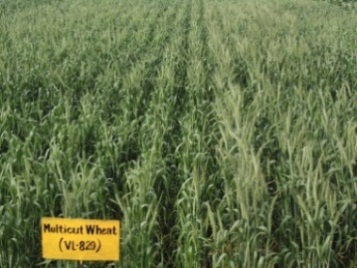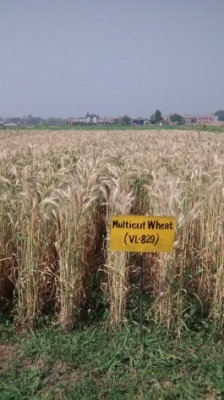चारा सह अनाज की बहुउद्देशीय गेहूं फसल।
Eastern region of India possesses large number of ruminant population (162 million) which is equivalent to almost 55 million adult cattle units that depend on available feed resources.
The dry and green roughages contribute to the tune of 80-90 percent in their ration and hence, a total of 184 million ton dry matter is required to feed the present population.
Generally, green fodder contribution varies from 25 to 40 percent in ruminant’s ration depending upon availability. But, at the same time, an acute shortage of green fodder prevails in the eastern part of India that varies from 82 to 89 percent. The main reason behind this gap is low land holding and negligible area under fodder production.
Feeding of fodder not only balances the different nutrients in the ration but also useful in health and reproduction point of view. Therefore, considering the above problem, a study was conducted to evaluate wheat as fodder cum grain production to mitigate fodder scarcity problem in the eastern part of India.
A plot was prepared by adding FYM @ 5 t/ha. Then, wheat (var. VL-829) was sown in the first week of November with the distance of 30 cm row-to-row and 10 cm plant-to-plant in different small plots of 10 m2 size each.
Crop was irrigated after 10d of germination and subsequently top dressing of urea @ 40kg/ha was applied. The crop, barring three plots,was then harvested for fodder use at 70d from 12cm base height (Photo 1a).

(Photo 1a: Wheat var. VL-829)
Second irrigation to all plots (cutting & without cutting) was applied just after fodder harvesting and subsequently second top dressing of urea @ 40kg/ha was also applied. Plants further grew and attained almost similar height after 20 days of fodder harvesting, and the height was matching to the plants of plots where fodder was not harvested (Photo 1b).

(Photo 1b & 1c: Wheat var. VL-829)
The ear head emergence was started in between 100 and 110 days in plots where fodder was not harvested, whereasthe same was started 10d later in fodder harvested plots (Photo 1c).
The third irrigation was provided at 130d of crop duration to all plots when ear head emergence completed. The matured crop was harvested at the age of 150d crop duration (Photo 1d).
Maximum grain yield of 3.30 t/ha was recorded from plots where fodder was not harvested. The harvesting of crop as fodder reduced the grain yield to the tune of 5.76 per cent.
However, additional yield of fodder as well as more straw yields contributed highest total biomass yield of 8.98 t/ha from plots where fodder was harvestedthan plots where fodder was not harvested (7.84 t/ha).
Thus, harvesting of fodder did not reduce overall biomass yield potential of the crop. The good quantity of fodder was harvested at 70 d crop duration which contained 17.46% crude protein on dry matter basis. The fodder contained permissible level of dry matter content (15.28%) also.
The digestion trial study was also conducted in heifer calves to know the nutritive value of wheat fodder. Wheat fodder was fed to three cattle heifer calves as sole ration for a period of one week.
Subsequent digestion trial was conducted for 5 days. Fodder offered and faeces voided each day were recorded and the sampleswere analyzed for calculation of nutritive value.
The dry matter intake of 2.61 (kg/100kg body weight) was recorded with digestibility of dry matter (78.00) and proteinper cent (72.84).
The digestible crude protein and energy values were found to be 12.72 percent and 3095 Kcal/kg, respectively in dry wheat fodder for cattle heifers.
The results showed that wheat fodder was very good in terms of nutritive value and intake point of view.
The farmers of eastern India are generally following paddy-wheat based cropping system.
Thus, it is recommended from the present study that wheat (var. VL-829) can be grown as a dual purpose (fodder cum grain) crop to mitigate the gap of fodder scarcity with little loss in grain production, but with overall maximum yield from total bio-mass.
Authors:
J.J. Gupta*, Amitava Dey and P.C. Chandaran
Division of Livestock & Fishery Management
ICAR Research Complex for Eastern Region, Patna, Bihar – 800 014
*Corresponding Author E-Mail:

